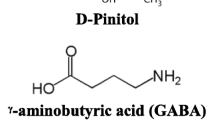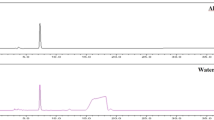Abstract
Three compounds, capsaicin, thymol and borneol, were initially screened for mutagenic activity using Salmonella typhimurium strains TA97, TA98 and TA100, with and without S9 metabolic activation, and 20 min standard preincubation time. Three other compounds, allyl isothiocyanate, eugenol and cinnamaldehyde, were screened for mutagenic activity as above, but with a prolonged, nonstandard preincubation time of up to 120 minutes. All six test compounds used in the assays are associated with the pungent properties of some specific spices in which the test compounds can be found to exist naturally. The first objective of this study was to observe if mutagenic activity can be correlated to the pungent properties of these six test compounds. However, due to toxicity and the observation that only capsaicin was mutagenic, using strain TA100 in the presence of S9 metabolic activation, it was not possible to deduce any relationship between mutagenicity and the test chemials' pungent properties. Naturally occurring capsaicin, found in the spice Capsicum annum, was detected and quantified using thin layer and gas chromatographic techniques.
The final objective was to detect the presence of antimutagenic factor(s) in C. annum that would suppress the mutagenicity of capsaicin. When the mutagenic capsaicin and 2-aminoanthracene were assayed in the presence of C. annum acetone extract, using strain TA100 with S9 metabolic activation, the mutagenic response of both the mutagens were reduced by approximately 50%. Assaying capsaicin and 2-aminoanthracene in the presence of chlorophyll, the mutagenic response of the two mutagens was reduced by less than 40%. From this observation it was inferred that chlorophyll can successfully suppress the mutagenicity activities of capsaicin and 2-aminoanthracene, together with other antimutagenic factors that were present in the acetone extract of C. annum.
Similar content being viewed by others
References
AOAC (1980) Official methods of analysis of the Association of Official Analytical Chemists, 13th ed., pp 49–51. Horwitz William, (ed) Washington, DC: AOAC Publishers
Abraham SK, Kesavan PC (1985) A preliminary analysis of the genotoxicity of a few spices in Drosophila. Mutat Res 143:219–223
Abraham S, Matthew K (1979) Mutagenic potential of green chilies. Cytologia 44:221–225
Ames BN, McCann J, Yamasaki E (1975) Methods for detecting carcinogens and mutagens with the Salmonella/mammalian-microsome mutagenicity test. Mutat Res 31:347–364
Ames BN (1979) Identifying environmental chemicals causing mutations and cancer. Science 221:1255–1264
— 1983. Dietary carcinogens and anticarcinogen. Science 221:1255–1264
Babish JC, Johnson B, Lisk D (1983) Mutagenicity of municipal sewage sludges of American cities. Environ Sci Technol 17:272–277
Batzinger RP, Ou SY, Beuding E (1978) Antimutagenic effects of 2(3)-tert-butyl-4-hydroxyanisole and antimicrobial agents. Cancer Res 38:4478–4485
Buchanan RL, Goldstein S, Budroe JD (1981) Examination of chili pepper and nutmeg oleoresins using the Salmonella/mammalian microsome mutagenicity assay. J Food Sci 47:330–331
Clayson DB (1980) Comparisons between in vitro and in vivo tests for carcinogenicity: An overview. Mutat Res 75:205–213
Correa P (1981) Nutrition and cancer: Epidemiological correlations. Raven Press, New York: pp 1–9
Goodenough (1984) Genetics, 3rd ed. Saunders College, New York Publishing, pp 224–226
Goodpasture CE, Arrighi FE (1976) Effects of food seasonings on the cell cycle and chromosome morphology of mammalian cells in vitro with special reference to turmeric. Food Cosmet Toxicol 14(1):9–14
Hartman K (1970) A rapid gas-liquid chromatographic determination for capsaicin in capsicum spices. J Food Sc 35:543–547
Homburger F, Boger E (1968) The carcinogenicity of essential oils, flavors, and spices: A review. Cancer Res 28:2371–2374
Inoue T, Morita K, Kata T (1981) Purification and properties of a plant desmutagenic factor for the mutagenic principle of tryptophan pyrolysate. Agric Biol Chem 45:345–353
Iwai K, Suzuki T, Fujiwake H (1979) Simultaneous micro determination of capsaicin and its four analogues by using high performance liquid chromatography and gas chromatography-mass spectrometry. J. Chromatog. 172:303–311
Kada T, Kaneko K, Matsuzaki T, Hara Y (1985) Detection and chemical identification of natural bioantimutagens. Mutat Res 150:127–132
Kimm S, Park S (1982) Evidences for the existence of antimutagenic factors in edible plants. Korean J Biochem 14:47–59
Lein PJ (1983) Mutagenic activity, as evidenced by the Ames Salmonella test, and chemical characterization of waters from Nolichucky river basin of Upper-East Tennessee. Masters Thesis, East Tennessee State University, Johnson City, TN
Masada Y, Hashimoto K, Inoue T, Suzuki M (1971) Analysis of the pungent principles of Capsicum annum by combined gas chromatography-mass spectrometry. J Food Sci 36:858–860
Maron DM, Ames BN (1983) Revised methods for the Salmonella mutagenicity test. Mutat Res 113:173–215
Mohr CD (1984) Bioaccumulation of mutagens in fish taken from four sites in Upper East Tennessee. Masters Thesis. East Tennessee State University. Johnson City, TN
Morita K, Hara M, Kada T (1978) Studies of natural desmutagens: Screening for vegetable and fruit factors active in inactivation of mutagenic pyrolysis products from amino acids. Agric Biol Chem 42:1235–1238
Nagabhushan M, Bhida SV (1985) Mutagenicity of chili extract and capsaicin in short term tests. Environ Mutagenesis 7:881–888
Nakamura H, Yamamoto T (1982) Mutagen and antimutagen in ginger, Zingiber officinale. Mutat Res 103:119–126
Neudecker T, Henschler D (1985) Allyl isothiocyanate is mutagenic in Salmonella typhimurium. Mutat Res 156:33–37
Neudecker T, Ohrlein K, Eder E, Henschler D (1983) Effect of methyl and halogen substitution in the alpha C position on the mutagenicity of cinnamaldehyde. Mutat Res 110:1–8
Purchase IFH, Longstaff A, Ashby J, Styles JA, Anderson D, Lefevre PA, Westwood FR (1976) Evaluations of six short term mutagenicity tests. Nature 264:624–627
Rammel C, Rannug U (1980) Short term mutagenicity tests. J Toxicol Environ Health 1075:145–155
Rockwell P, Raw I (1979) A mutagenic screening of various herb, spices and food additives. Nutr Cancer 1(4):10–15
Sugimura T, Kawachi T, Nagao M, Yahagi T (1981) Mutagens in food as causes of cancer. Nutrition and Cancer, Raven Press: New York, pp 1–9
Suzuki T (1980) Effective separation of capsaicin and its analogues by reversed phase high performance thin layer chromatography. J Chromatog 173:217–223
Yahagi T, Nagao M, Matshima T, Seino Y, Sawamura S, Kawachi T, Sugimura T (1979) An improved method for detecting mutagens (abstract). Mutat Res 53:285
Yamaguchi T, Yamashita Y, Abe T (1980) Desmutagenic activity of peroxidase on autoxidized linolenic acid. Agric Biol Chem 90:119–124
Author information
Authors and Affiliations
Rights and permissions
About this article
Cite this article
Azizan, A., Blevins, R.D. Mutagenicity and antimutagenicity testing of six chemicals associated with the pungent properties of specific spices as revealed by the Ames Salmonella/microsomal assay. Arch. Environ. Contam. Toxicol. 28, 248–258 (1995). https://doi.org/10.1007/BF00217624
Received:
Revised:
Issue Date:
DOI: https://doi.org/10.1007/BF00217624




